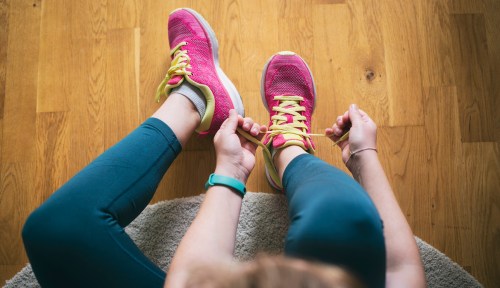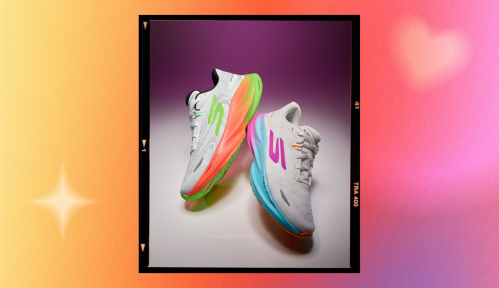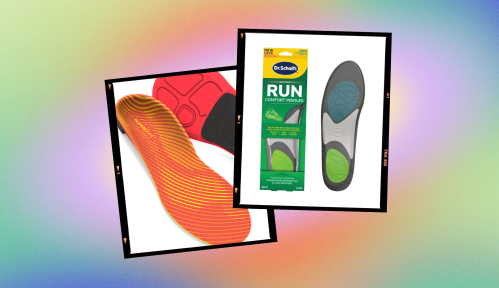Our editors independently select these products. Making a purchase through our links may earn Well+Good a commission
What Does It Take To Make Sneakers Truly ‘Sustainable’?
Sustainability experts break down the truth behind sneaker sustainability claims, and what it would take to make footwear eco-friendly.

Recycled laces. Castor bean soles. Vegan fiber uppers. Merino wool liners. Just about every sportswear brand today appears to have a sustainable solution when it comes to workout shoes. But are plant-based and recycled sneakers actually better for the environment?
Experts in This Article
It’s an important question to ask because the sneaker industry has an enormous impact on our planet: If it were a country, it would be the world’s seventeenth largest polluter, according to RunRepeat research. And when you consider that, on average, Americans own two pairs of running shoes at any given time, and most only last between 300 and 500 miles, our sneaker habits create a staggering amount of annual landfill.
In recognition of the climate crisis, many brands today are promoting their products as “carbon-neutral,” “low-emission,” and “eco-friendly.” But, according to sustainability experts, this is largely lip service.
“There really aren’t any good choices out there. That’s the problem,” says Nancy Landrum, professor of sustainability management at Munich Business School. Although changes in the footwear industry might be “a step in the right direction,” she says, “don’t mistake or think that they are sustainable. They are not.”
Sure, there’s some progress being made. But between polluting manufacturing processes and fossil fuel–derived materials, shoes that claim they’re climate-friendly are simply less of a bad thing.
“Companies are not adopting sustainability practices in design that will create true sustainability in the products and instead are only making minimal improvements,” was the conclusion of an upcoming Loyola University Chicago postgraduate study that looked at the sustainability claims of six shoes.
Or, as a 2021 report by RunRepeat put it, eco-sneakers “are not going to save the planet. All they’ll do is kill it a little more slowly.”
We still rely on toxic materials that don’t break down
Even shoes claiming to be plant-based are predominantly made from potentially harmful materials. “We found that as much as 80 percent of the shoe was still traditionally made with all the toxins—the glues, formaldehyde, leather products,” says Landrum.
Toxic chemicals such as titanium oxide, ethylene-vinyl acetate, isocyanates, and xylenes used to create the various components of sneakers do not break down easily, and when released into the atmosphere, they can be toxic to wildlife, particularly aquatic animals. With up to 15 different materials and four types of plastic, a shoe can take 1,000 years to break down.
Meanwhile, materials like leather, natural rubber, and wool have a huge impact on global warming due to their carbon emissions, replacement of natural forests, and water waste, and create the greatest eutrophication potential (increasing toxic algae growth), according to a review in the Journal for a Sustainable Circular Economy.
To tackle this, footwear brands are heavily promoting the use of recycled materials. But sustainability experts say this doesn’t remove the toxic components from eventually reaching landfill, even if it does delay it. What’s more, the recycled materials often only make up about 10 percent of an entire shoe.
“The integration of recycled materials is one thing that most companies are doing,” says Landrum, who worked with grad student Gaby Katz from Loyola University Chicago on the sustainability claims research. “But that is not enough. Because if we look at the manufacturing processes, if you look at all of the toxic chemicals that are used, just integrating a few recycling materials is simply not enough.”
Still, there are some steps in the right direction. Allbirds publishes a cradle-to-grave carbon emission calculation on their shoes, while Adidas has designed a 100-percent recyclable sneaker manufactured from toxic-free glues, and Vivobarefoot avoids the use of harmful chemicals, such as polyurethane powder.
Eco claims are unregulated
One of the biggest problems for consumers is that shoes branded as sustainable are self-certified by companies rather than meeting an internationally-recognized set of standards.
In her research, Katz found no running shoes were certified by Cradle to Cradle, which evaluates materials, product circularity, water and soil stewardship, clean air, climate protection, and social fairness. “Shoe companies are adopting individualized, self-defined criteria and standards for sustainability rather than utilizing existing standards,” Katz wrote.
The problem with this, of course, is that there is no way to know if claims are anything more than marketing rhetoric, points out Landrum. Katz’s research found companies provided little evidence for their sustainability claims, and some even contradicted it: One brand emphasized its castor bean material, while simultaneously revealing that 80 to 100 percent of the shoe was still petroleum-based.
Another issue is companies defining sustainability as purely an environmental measure while ignoring the social and economic impacts. “Sustainability also focuses on people, to ensure the work environment is healthy and workers receive a living wage, and positive economic impact for the company and communities where it operates, including supply chain communities,” Katz wrote in her study.
So how can shoes be sustainable?
Rather than relying on footwear brands to produce sustainable sneakers, the solution may actually lie in the hands of consumers.
Sustainable engineering expert Shahin Rahimifard, PhD, of Loughborough University Centre for Sustainable Manufacturing and Recycling Technologies, says a focus on repair and longevity rather than consumption is key. “Perhaps the most important action by all manufacturers, including footwear producers, is to identify how they can create economic growth but not through producing a large volume of products and encouraging increased consumption,” he says.
Meanwhile, the RunRepeat study reports that if everyone bought just one less pair of sneakers per year, it would cut the carbon footprint of the industry by a third. The question is, when will footwear companies catch on and start building shoes that will last us longer? Encouraging fewer purchases isn’t exactly in the interest of their bottom line.
Yet there is at least one example of a step in that direction: NNormal, a new shoe company founded by the legendary ultrarunner Kilian Journet and the Spanish brand Camper, has made it a point to produce durable products that last longer than traditional running shoes—with classic designs that won’t fall out of fashion after one season. They are made from materials like polyester, nylon, and rubber that have a negative environmental impact, yes, but rather than quickly racing toward the trash can, they’re intentionally created so that you can run in them for hundreds and hundreds of miles.
Sign up for the Well+Good SHOP Newsletter
Get exclusive deals on wellness, beauty, fitness, and food products that have been hand-picked by our editors.
Got it, you've been added to our email list.










